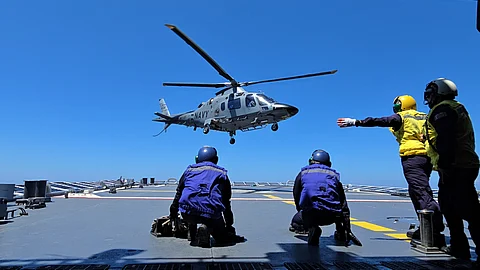
- NEWS
- the EDIT
- COMMENTARY
- BUSINESS
- LIFE
- SHOW
- ACTION
- GLOBAL GOALS
- SNAPS
- DYARYO TIRADA
- MORE

ABOARD BRP JOSE RIZAL, WPS — The joint air and sea military drills of the Philippines, United States and Japan pressed forward east of Bajo de Masinloc (Scarborough Shoal) over the weekend amid audacious efforts by a Chinese warship to disrupt their operation.
As the three allied nations executed their Multilateral Maritime Cooperative Activity (MMCA), a Chinese Type 054A Jiangkai II-Class missile frigate, bow number 574, prowled at a distance.
But as the exercise gained momentum, the gray hull of the warship inched closer, challenging the resolve of the Filipino, American and Japanese sailors and airmen.
Commander Irvin Ian Robles, skipper of BRP Jose Rizal, recounted the tense moments on Sunday.
“Before reaching our rendezvous point, we detected the Chinese frigate and immediately issued a challenge,” Robles told reporters aboard the Philippine Navy’s first guided-missile frigate.
Silence. The Chinese warship did not respond.
Then, as midday approached and the Japanese warship JS Noshiro joined the formation alongside the USS Shoup and BRP Jose Rizal, the Chinese vessel made its move. It began maneuvering dangerously close, an unmistakable act of intimidation.
“There was a moment, around noon, when they attempted to close in,” Robles said. “We confronted them, demanded their intent, and instructed them to alter course.”
The Philippine Navy made its position clear. “We informed them they were in Philippine waters,” he continued.
After repeated radio challenges, the Chinese vessel finally veered off. “They responded that they were just conducting ‘normal navigation,’” Robles added, skepticism evident in his voice.
Despite the Chinese presence, the MMCA carried on uninterrupted. The warships from the three allied nations tightened their formation in division tactics maneuvers, radio signals crackling as they coordinated.
American sailors deployed a rigid-hull inflatable boat to transfer personnel between the USS Shoup and BRP Jose Rizal, reinforcing the seamless cooperation between the forces.
Above, a high-stakes aerial ballet unfolded. The US Navy’s MH-60R Seahawk and P-8A Poseidon aircraft roared overhead, conducting maritime domain awareness exercises, while the Philippine Navy’s Agusta Westland AW109 helicopter and C90 aircraft joined in for reconnaissance and tactical operations.
“This exercise proves we are at par with other nations,” Robles asserted. “We are not just participants—we are partners in upholding a rules-based order and freedom of navigation.”
US Navy Lt. Alexander Horvath echoed the sentiment.
“We are strong allies,” he said. “These exercises bring us closer to our goal — a free and open Indo-Pacific.”
The latest intrusion was part of an ongoing pattern of Chinese encroachment in the region.
Just last month, the Naval Forces Northern Luzon (NFNL) reported three Chinese warships illegally navigating near Bajo de Masinloc.
In January, China’s so-called “Monster Ship,” the massive 165-meter China Coast Guard vessel 5901, brazenly lingered within the Philippines’ exclusive economic zone for days.
The territorial dispute between the Philippines and China over the West Philippine Sea has been a longstanding source of tension.
China claims nearly the entire South China Sea, including areas within the Philippines’ 200-nautical-mile exclusive economic zone (EEZ), citing historical rights.
However, in 2016, the Permanent Court of Arbitration in The Hague ruled in favor of the Philippines, invalidating China’s sweeping claims and affirming the country’s sovereign rights over its EEZ.
Despite this ruling, China has continued its aggressive activities, constructing artificial islands, deploying naval and militia vessels and harassing Filipino fishermen and patrols in the region.
The Philippines, backed by its allies, continues to assert its rights through diplomatic protests, military patrols and joint exercises like the MMCA.
